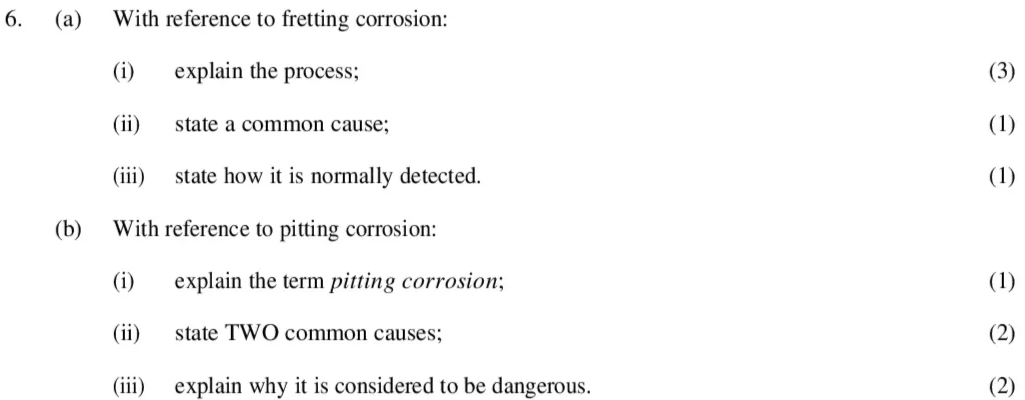Study Notes Quiz

(a) Describe the problems associated with two dissimilar metals in contact in the presence of sea water.(4)
(b) Describe THREE different methods that may be used to reduce the problems described in part (a).(6)

With reference to marine corrosion:
(a) list EIGHT factors that influence the rate of corrosion for an unprotected metal surface;(4)
(b) explain the process of galvanic corrosion;(4)
(c) state TWO major factors influencing the severity of galvanic corrosion.(2)

With reference to the cathodic protection of hull fittings:
(a) explain how sacrificial anodes achieve this;(2)
(b) state where sacrificial anodes would be fitted and why;(4)
(c) describe an impressed current system, stating the principle on which it works.(4)

Explain how corrosion and its effects can be minimised in seawater cooling systems.(10)

With reference to hot docking:
(a) explain how this occurs, stating its effects;(6)
(b) describe the operation of TWO devices that will prevent this occuring.(4)

(a) With reference to fretting corrosion:
(i) explain the process;(3)
(ii) state a common cause;(1)
(iii) state how it is normally detected.(1)
(b) With reference to pitting corrosion:
(i) explain the term pitting corrosion;(1)
(ii) state TWO common causes;(2)
(iii) explain why it is considered to be dangerous.(2)

Explain EACH of the following terms:
(a) galvanic corrosion;(2)
(b) cavitation damage;(2)
(c) erosion damage;(2)
(d) stress corrosion;(2)
(e) atmospheric corrosion.(2)

A vessel has been laid up for a considerable time with shore power connected. Routine underwater hull inspections reveal an unusually high deterioration rate of the vessel’s anodes. Assuming the dockside wiring, shore power connections and bonding systems are all in good condition and correctly connected:
(a) explain how this may occur;(8)
(b) state TWO devices that should be fitted to prevent this situation occurring.(2)

A drydock inspection of the stainless steel alloy propeller shafts has revealed serious pitting corrosion of the shafts in the region where the shafts pass through the stern tube. The stern tube arrangement consists of a shaft seal and a sea-water flooded stern tube with cutless bearing at the aft (sea) end.
(a) Describe the possible reasons for this corrosion.(6)
(b) Describe the modifications that could be made to the stern tube arrangement to reduce the likelihood of future shaft corrosion.(4)